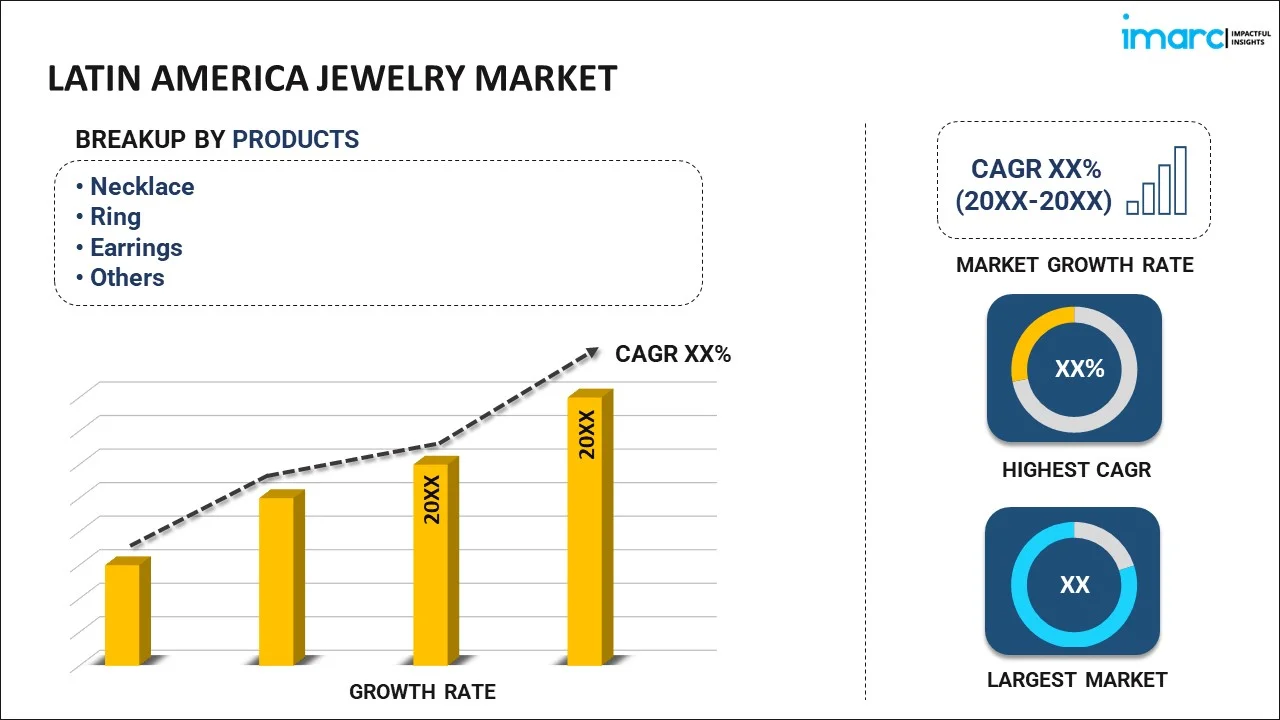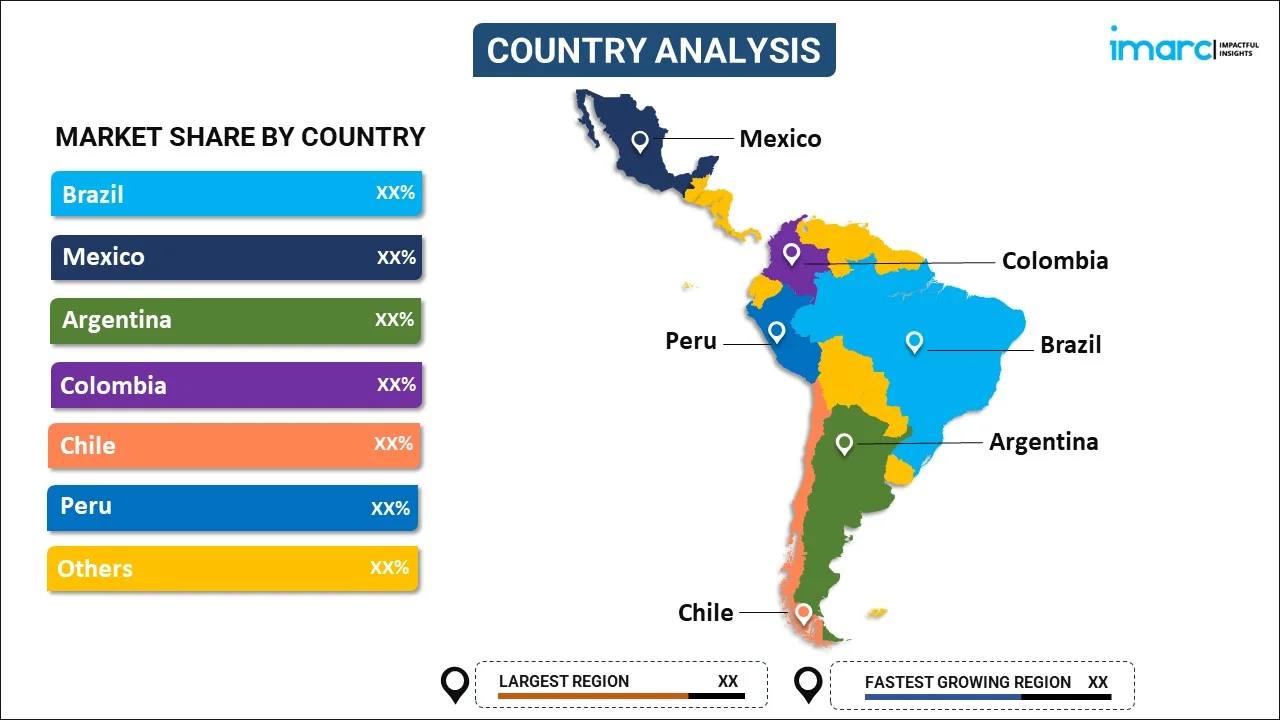
Latin America Jewelry Market Report by Product (Necklace, Ring, Earrings, Bracelet, and Others), Material (Gold, Platinum, Diamond, and Others), and Country 2025-2033
Latin America Jewelry Market:
Latin America jewelry market size reached USD 23.8 Billion in 2024. Looking forward, IMARC Group expects the market to reach USD 37.5 Billion by 2033, exhibiting a growth rate (CAGR) of 4.8% during 2025-2033. The rise of online retail, which has transformed the jewelry industry, providing consumers with convenient access to a wide range of products, is driving the market.
|
Report Attribute
|
Key Statistics
|
|---|---|
|
Base Year
|
2024
|
|
Forecast Years
|
2025-2033
|
|
Historical Years
|
2019-2024
|
|
Market Size in 2024
|
USD 23.8 Billion |
|
Market Forecast in 2033
|
USD 37.5 Billion |
| Market Growth Rate 2025-2033 | 4.8% |
Latin America Jewelry Market Analysis:
- Major Market Drivers: The increasing disposable income of consumers has catapulted the demand for luxury and personalized adornments, including jewelry. Moreover, the growing trend of self-expression and individualism has contributed significantly to the market dynamics.
- Key Market Trends: The rising importance of sustainable and ethically sourced materials has prompted a shift in consumer preferences, with eco-conscious buyers opting for jewelry that aligns with their values, further propelling the industry's demand. Furthermore, advancements in technology have revolutionized the industry, with online platforms providing a convenient avenue for both buyers and sellers, thereby escalating the Latin America jewelry market growth.
- Competitive Landscape: The Latin America jewelry market analysis report has also provided a comprehensive analysis of the competitive landscape in the market. Also, detailed profiles of all major companies have been provided.
- Geographical Trends: Economic stability and growth spur demand for luxury goods, including jewelry. Brazil's growing middle and upper classes contribute to increasing purchasing power. Moreover, Mexico has a rich tradition of silver jewelry, which continues to be popular. Mexican artisans are known for their high-quality silverwork.
- Challenges and Opportunities: High fluctuation rates and the rising import duties and taxes on luxury items are hampering the market's growth. However, the emergence of online shopping and digital platforms offers new avenues for reaching customers and expanding market reach.
Latin America Jewelry Market Trends:
Rising Demand for Luxury Goods
The rising demand for luxury goods is a major driver of growth in the Latin American jewelry market. For instance, according to IMARC, Brazil luxury goods market size is projected to exhibit a growth rate (CAGR) of 4.07% during 2024-2032. As Latin America’s economic conditions improve, a growing number of affluent consumers are emerging. This wealthier demographic is more inclined to spend on high-end, luxury items, including fine jewelry. These factors are further contributing to the Latin American jewelry market share.
Increasing Popularity of Diamonds
Customers' spending power has expanded due to rising income levels in the country, and the emerging fashion trends are driving up demand for fine jewelry throughout the region. Luxury firms have refocused their business strategies to capitalize on these shifts through technology innovation and global investment. For example, in 2020, Muzo Emerald Colombia collaborated with ten designers to release a new collection of emerald jewelry. These factors augment the Latin America jewelry market demand.
Expanding E-Commerce Sector
The growing e-commerce sector is one of the key factors driving the market's growth. For instance, according to Statista, e-commerce consumers in Latin America are expected to reach 290 million by 2024. By 2029, this amount would have increased by 52%, with around 419 million users across the region. The growth of online shopping platforms is making jewelry more accessible to a broader audience. E-commerce allows consumers to explore and purchase a wide range of jewelry from the comfort of their homes. These factors are further positively influencing the Latin America jewelry market forecast.
Latin America Jewelry Market Segmentation:
IMARC Group provides an analysis of the key trends in each segment of the market, along with forecasts at the regional and country levels for 2025-2033. Our report has categorized the market based on product and material.
Breakup by Product:

- Necklace
- Ring
- Earrings
- Bracelet
- Others
The report has provided a detailed breakup and analysis of the market based on the product. This includes necklace, ring, earrings, bracelet, and others.
Necklaces often feature designs with cultural or traditional significance, including motifs inspired by indigenous art or local heritage. For instance, pieces may incorporate traditional gemstones like emeralds or opals. Moreover, rings, especially engagement and wedding bands, are highly significant in Latin America. Diamonds and precious metals like gold and platinum are commonly used, reflecting both personal and cultural values. Furthermore, earrings in Latin America range from classic stud earrings to elaborate chandelier designs. Different styles cater to various occasions, from casual everyday wear to formal events, further driving the market's growth.
Breakup by Material:
- Gold
- Platinum
- Diamond
- Others
A detailed breakup and analysis of the market based on the material have also been provided in the report. This includes gold, platinum, diamond, and others.
According to the Latin America jewelry market outlook, gold has deep cultural and historical significance in Latin America. The region is renowned for its rich gold heritage, dating back to pre-Columbian civilizations like the Aztecs and Incas, who valued gold both for its beauty and its symbolic meaning. Moreover, platinum is valued for its rarity, durability, and high-end appeal. It is often associated with luxury and is preferred for high-end, fine jewelry. Besides this, diamonds are highly sought after in Latin America for their association with luxury, elegance, and enduring value. They are often used to signify important life events, such as engagements, weddings, and anniversaries.
Breakup by Country:

- Brazil
- Mexico
- Argentina
- Colombia
- Chile
- Peru
- Others
The report has also provided a comprehensive analysis of all the major regional markets, which include Brazil, Mexico, Argentina, Colombia, Chile, Peru, and Others.
According to the Latin America jewelry market report, Brazil has a large and growing middle class that is increasingly able to afford luxury and fashion jewelry. This expanding consumer base drives demand for both high-end and affordable pieces. Moreover, Mexico’s robust tourism industry creates a significant demand for jewelry as souvenirs and luxury items, especially in tourist hotspots like Cancún and Mexico City. Besides this, Argentina has a strong luxury market with a growing appetite for high-end jewelry, driven by affluent consumers in cities like Buenos Aires.
Competitive Landscape:
The Latin America jewelry market research report has also provided a comprehensive analysis of the competitive landscape. Competitive analysis such as market structure, key player positioning, top winning strategies, competitive dashboard, and company evaluation quadrant has been covered in the report. Also, detailed profiles of all major companies have been provided.
Latin America Jewelry Market News:
- June 2024: PdPaola, a Spanish jewelry brand, which opened new points of sale in Peru and Mexico, launched its set up on Puerto Rico.
- May 2024: The Gem and Jewelry Export Promotion Council (GJEPC) organized a delegation to Latin America to boost exports and build stronger ties in the region.
- August 2023: Pandora unveiled three new jewelry collections of lab-grown diamonds: Pandora Nova, Pandora Era, and Pandora Talisman in Mexico and Brazil.
Latin America Jewelry Market Report Scope:
| Report Features | Details |
|---|---|
| Base Year of the Analysis | 2024 |
| Historical Period | 2019-2024 |
| Forecast Period | 2025-2033 |
| Units | Billion USD |
| Scope of the Report | Exploration of Historical Trends and Market Outlook, Industry Catalysts and Challenges, Segment-Wise Historical and Predictive Market Assessment:
|
| Products Covered | Necklace, Ring, Earrings, Bracelet, Others |
| Materials Covered | Gold, Platinum, Diamond, Others |
| Countries Covered | Brazil, Mexico, Argentina, Colombia, Chile, Peru, Others |
| Customization Scope | 10% Free Customization |
| Post-Sale Analyst Support | 10-12 Weeks |
| Delivery Format | PDF and Excel through Email (We can also provide the editable version of the report in PPT/Word format on special request) |
Key Questions Answered in This Report:
- How has the Latin America jewelry market performed so far and how will it perform in the coming years?
- What has been the impact of COVID-19 on the Latin America jewelry market?
- What is the breakup of the Latin America jewelry market on the basis of product?
- What is the breakup of the Latin America jewelry market on the basis of material?
- What are the various stages in the value chain of the Latin America jewelry market?
- What are the key driving factors and challenges in the Latin America jewelry?
- What is the structure of the Latin America jewelry market and who are the key players?
- What is the degree of competition in the Latin America jewelry market?
Key Benefits for Stakeholders:
- IMARC’s industry report offers a comprehensive quantitative analysis of various market segments, historical and current market trends, market forecasts, and dynamics of the Latin America jewelry market from 2019-2033.
- The research report provides the latest information on the market drivers, challenges, and opportunities in the Latin America jewelry market.
- The study maps the leading, as well as the fastest-growing, markets. It further enables stakeholders to identify the key country-level markets within the region.
- Porter's five forces analysis assists stakeholders in assessing the impact of new entrants, competitive rivalry, supplier power, buyer power, and the threat of substitution. It helps stakeholders to analyze the level of competition within the Latin America jewelry industry and its attractiveness.
- The competitive landscape allows stakeholders to understand their competitive environment and provides insight into the current positions of key players in the market.
Need more help?
- Speak to our experienced analysts for insights on the current market scenarios.
- Include additional segments and countries to customize the report as per your requirement.
- Gain an unparalleled competitive advantage in your domain by understanding how to utilize the report and positively impacting your operations and revenue.
- For further assistance, please connect with our analysts.
 Inquire Before Buying
Inquire Before Buying
 Speak to an Analyst
Speak to an Analyst
 Request Brochure
Request Brochure
 Request Customization
Request Customization




.webp)




.webp)












